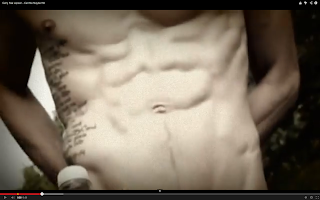Critics of the male gaze have argued that the gaze could be adopted by both male and female subjects. It is noted that the male is not always the controlling subject nor is the female always the passive object. Teresa de Lauretis argued that the female spectator does not simply adopt a masculine reading position but is always involved in a ‘double-identification’ with both the passive and active subject positions. Jackie Stacey questioned ‘Do women necessarily take up a feminine and men a masculine spectator position?' It is widely noted that there has been an increasing display and sexualisation of the male body. Shots used when portraying the female gaze include close ups and tilts which reveal the man gradually.
Here is a 30 second clip of the music video for Call Me Maybe by Carly Rae Jepsen. This clip shows evidence of the female gaze as Carly is watching the man, but he is unaware that he is being watched. As the video progresses, there are stunning shots of the mans body clearly showing off his chiseled physique. These are fragmented shots which show parts of his body at each time. The shots used are mid shots and close ups to draw in the gaze. Additionally, a tilt has been used to gradually reveal his body.
This shot shows Carly watching the man from behind the window, he in the moment cannot see her. This is important because as the audience we realise that it is from her perspective that we are seeing him.
This shot was taken from part of the tilt. It is a fragmented shot as we are only shown a particular part of his body which is where the gaze begins. It is a very defining shot.
This is a clear example of the female gaze. She is wrongfully watching him from her window and is essentially looking at something she shouldn't be looking at, but as the audience we are drawn in.



No comments:
Post a Comment